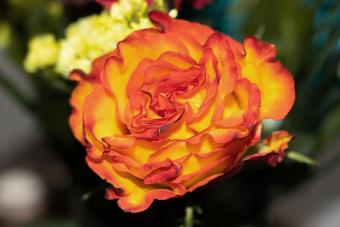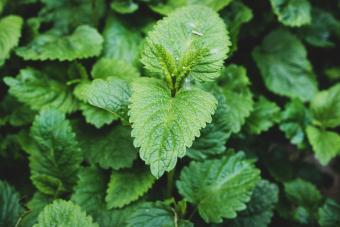
Looking to add both scent and beauty to your home? Growing fragrant indoor plants is a great way to accomplish both goals. From flowering plants to aromatic herbs, there are a lot of indoor plants that smell good. When you choose any of these best-smelling indoor plants for your home or office, your nose will thank you!
Indoor Plants With Fragrant Flowers
The flowering plants listed here grow well indoors and produce blooms that are known for being quite fragrant. Getting flowering plants to bloom indoors requires a lot of light, so you may need to use grow lights. You may also need to put them outside during certain times of the year, based on each plant's individual needs. The plants listed here are highly fragrant only when they are blooming.
Frangipani

Frangipani (Plumeria rubra) is often called nosegay or plumeria. This tropical plant has fragrant blooms and - with enough light - makes a great houseplant. It needs at least six hours of bright sunlight per day, though you can supplement available natural light with a grow light. Frangipani thrives between 65 and 80°F. It likes humidity, so put the container on a saucer of damp pebbles. Let the soil completely dry out between waterings. Your love and care will definitely pay off with lush, tropical aromas that will whisk your imagination straight to the Hawaiian Islands.
Lavender

With enough sunlight, lavender (Lavandula) - a plant known for fragrant flowers - can grow and bloom indoors. It needs a lot of sunlight - as much as possible - and cool temperatures (so keep it away from heating vents). Rotate the pot every week to 10 days, so all sides of the plant get equal sun exposure. If your plant doesn't bloom, use grow lights to boost exposure. Let the soil completely dry out, then completely drench it with water. Lavender has a delicate, powdery, floral scent that boosts relaxation.
Tea Rose Begonia

If you love begonias and want to grow them indoors, tea rose begonia (Begonia 'Tea Rose') is a great variety to choose. This fibrous, ever-blooming begonia is particularly well-suited for growing as a houseplant. Most begonias aren't particularly fragrant, but this variety's blooms have a sweet aroma. It requires bright light - ideally dappled - and humidity to thrive. Water this plant when the surface of the soil gets dry.
White Jasmine

White jasmine (Jasminum polyanthum) is a climbing plant that grows well indoors and has a wonderful fragrance when it blooms. Put it outside for four to six weeks in fall, when the temperature is cool but not freezing, to help it set buds to bloom during winter, usually in February. Indoors, keep it in a sunny window in a cool room. Boost humidity by putting the container on a tray filled with damp pebbles. Water when the top half inch of soil is dry. White jasmine has a heady, sweet, fruity aroma.
Fragrant Herbs to Grow Indoors
If you want to grow indoor plants that are fragrant all the time, consider growing an indoor herb garden. Not only will aromatic culinary herbs help make your home smell great, but you'll also have ongoing access to fresh herb plants any time you want to use them in recipes, or to make herbal tea or herbal remedies. They also need bright, indirect light - so you may need to supplement natural light with grow lights, especially in winter.
Basil

Basil (Ocimum basilicum) is a great herb to grow indoors. Not only is it easy to grow indoors, it is incredibly fragrant. Plus, it's super-useful in the kitchen. Fresh basil adds a powerful punch of flavor to food that's so much better than you can get from dried basil. It needs about six hours of sunlight per day, so put it in a sunny area or supplement with a grow light. Add water when the top inch of soil gets dry. Basil has a peppery, minty aroma that smells heavenly.
Cilantro

Cilantro (Coriandrum sativum) has a strong citrusy aroma that smells like both lemon and lime. It doesn't transplant well, so it's best to grow your indoor cilantro plants from seeds or propagated stem cuttings. Cilantro needs six to eight hours of bright light daily. It's fine to supplement natural light with a grow light. Water cilantro when the surface of the soil gets dry.
If cilantro tastes like soap to anyone in your home, it will probably also smell bad to them.
Lemon Balm

The leaves of lemon balm (Melissa officinalis) plants smell like lemon, with a hint of mint - which is not surprising because this plant is in the mint family. It has a gentle smell, but if you rub a few leaves between your thumb and finger (one at a time), the fragrance will get stronger for a while. Lemon balm likes bright, indirect light. Add water when the surface of the soil gets dry.
Mint

All varieties of mint (Mentha) grow well indoors, and they also all smell great. There are several types of mint, including sweet mint, peppermint, spearmint, and chocolate mint (it has a chocolatey scent but does not taste like chocolate). Consider growing several kinds for maximum aroma. You can use all kinds of mint in cooking or to make mint tea. Mint does best in bright indirect light. Add water when the soil's surface dries out.
Bring Outdoor Fragrance Indoors
In addition to growing indoor plants that smell good, you can also bring fragrant cut flowers from your garden indoors to scent your home. It's easier to grow fragrant blooming plants outdoors than indoors, so displaying cut flowers is a good - and potentially less labor intensive - way to enjoy the smell of seasonal blooms.
For example, gardenia and tuberose blooms smell incredible, but both plants are challenging to grow indoors. If you have them growing outside, you can take stem cuttings to display in a vase indoors. Not only will they look lovely, but they will also smell wonderful.
Enjoy Beautiful Sights and Smells
Plants - and cut flowers - do a lot to beautify a space. The fragrant plants listed here are a treat for the senses. They smell just as wonderful as they are beautiful. It's well-worth the effort it takes to grow them indoors.







